Transcription Factor MaHMG, the High-Mobility Group Protein, Is Implicated in Conidiation Pattern Shift and Stress Tolerance in Metarhizium acridum
Abstract
1. Introduction
2. Materials and Methods
2.1. Strains and Growth Conditions
2.2. Constructions of Mutants
2.3. Conidial Capacity Assays
2.4. Observation of Conidiation Patterns and Hyphal Septum Assays
2.5. Stress Tolerance Assays
2.6. Determination of Trehalose Content
2.7. RT-qPCR Assays
2.8. RNA Sequencing
2.9. Data Analysis
3. Results
3.1. Bioinformatics Analysis of MaHMG
3.2. MaHMG Deletion Reduces Conidiation Yield and Delays Conidiation in M. acridum
3.3. MaHMG Deletion Shifts Conidiation Pattern from Microcycle to Normal Conidiation in M. acridum
3.4. MaHMG Deletion Compromises UV-B and Heat-Shock Tolerance and Enhances Sensitivity to Cell-Wall-Perturbing Agents in M. acridum
3.5. Identification of MaHMG-Regulated Differential Genes During Conidiation Pattern Shift by RNA-seq
4. Discussion
5. Conclusions
Supplementary Materials
Author Contributions
Funding
Institutional Review Board Statement
Informed Consent Statement
Data Availability Statement
Conflicts of Interest
References
- Wang, C.; Wang, S. Insect pathogenic fungi: Genomics, molecular interactions, and genetic improvements. Annu. Rev. Entomol. 2017, 62, 73–90. [Google Scholar] [CrossRef] [PubMed]
- Ortiz-Urquiza, A.; Luo, Z.; Keyhani, N.O. Improving mycoinsecticides for insect biological control. Appl. Microbiol. Biotechnol. 2015, 99, 1057–1068. [Google Scholar] [CrossRef] [PubMed]
- Zhou, J.; Wang, S.; Xia, Y.; Peng, G. Maazar, a Zn2Cys6/fungus-specific transcriptional factor, is involved in stress tolerance and conidiation pattern shift in Metarhizium acridum. J. Fungi 2024, 10, 468. [Google Scholar] [CrossRef] [PubMed]
- Zhang, S.; Peng, G.; Xia, Y. Microcycle conidiation and the conidial properties in the entomopathogenic fungus Metarhizium acridum on agar medium. Biocontrol Sci. Technol. 2010, 20, 809–819. [Google Scholar] [CrossRef]
- Li, S.; Myung, K.; Guse, D.; Donkin, B.; Proctor, R.H.; Grayburn, W.S.; Calvo, A.M. Fvve1 regulates filamentous growth, the ratio of microconidia to macroconidia and cell wall formation in Fusarium verticillioides. Mol. Microbiol. 2006, 62, 1418–1432. [Google Scholar] [CrossRef]
- Son, H.; Kim, M.G.; Min, K.; Lim, J.Y.; Choi, G.J.; Kim, J.C.; Chae, S.K.; Lee, Y.W. Weta is required for conidiogenesis and conidium maturation in the ascomycete fungus Fusarium graminearum. Eukaryot. Cell 2014, 13, 87–98. [Google Scholar] [CrossRef]
- Etxebeste, O.; Garzia, A.; Espeso, E.A.; Ugalde, U. Aspergillus nidulans asexual development: Making the most of cellular modules. Trends Microbiol. 2010, 18, 569–576. [Google Scholar] [CrossRef]
- Park, H.S.; Yu, J.H. Genetic control of asexual sporulation in filamentous fungi. Curr. Opin. Microbiol. 2012, 15, 669–677. [Google Scholar] [CrossRef]
- Seo, J.A.; Guan, Y.; Yu, J.H. Flug-dependent asexual development in Aspergillus nidulans occurs via derepression. Genetics 2006, 172, 1535–1544. [Google Scholar] [CrossRef]
- Zou, Y.; Li, C.; Wang, S.; Xia, Y.; Jin, K. Macts1, an endochitinase, is involved in conidial germination, conidial yield, stress tolerances and microcycle conidiation in Metarhizium acridum. Biology 2022, 11, 1730. [Google Scholar] [CrossRef]
- Dai, H.; Zou, Y.; Xia, Y.; Jin, K. Maeng1, an endo-1,3-glucanase, contributes to the conidiation pattern shift through changing the cell wall structure in Metarhizium acridum. J. Invertebr. Pathol. 2024, 207, 108204. [Google Scholar] [CrossRef]
- Li, C.; Xia, Y.; Jin, K. The c2h2 zinc finger protein mancp1 contributes to conidiation through governing the nitrate assimilation pathway in the entomopathogenic fungus Metarhizium acridum. J. Fungi 2022, 8, 942. [Google Scholar] [CrossRef]
- Hu, X.; Li, B.; Li, Y.; Xia, Y.; Jin, K. Mapac2, a transcriptional regulator, is involved in conidiation, stress tolerances and pathogenicity in Metarhizium acridum. J. Fungi 2025, 11, 100. [Google Scholar] [CrossRef]
- Tong, S.M.; Feng, M.G. Phenotypic and molecular insights into heat tolerance of formulated cells as active ingredients of fungal insecticides. Appl. Microbiol. Biotechnol. 2020, 104, 5711–5724. [Google Scholar] [CrossRef] [PubMed]
- Sancar, A. Structure and function of DNA photolyase and cryptochrome blue-light photoreceptors. Chem. Rev. 2003, 103, 2203–2238. [Google Scholar] [CrossRef] [PubMed]
- Idnurm, A.; Verma, S.; Corrochano, L.M. A glimpse into the basis of vision in the kingdom Mycota. Fungal Genet. Biol. 2010, 47, 881–892. [Google Scholar] [CrossRef] [PubMed]
- Shimura, M.; Ito, Y.; Ishii, C.; Yajima, H.; Linden, H.; Harashima, T.; Yasui, A.; Inoue, H. Characterization of a Neurospora crassa photolyase-deficient mutant generated by repeat induced point mutation of the phr gene. Fungal Genet. Biol. 1999, 28, 12–20. [Google Scholar] [CrossRef]
- Tagua, V.G.; Pausch, M.; Eckel, M.; Gutiérrez, G.; Miralles-Durán, A.; Sanz, C.; Eslava, A.P.; Pokorny, R.; Corrochano, L.M.; Batschauer, A. Fungal cryptochrome with DNA repair activity reveals an early stage in cryptochrome evolution. Proc. Natl. Acad. Sci. USA 2015, 112, 15130–15135. [Google Scholar] [CrossRef]
- Chatterjee, N.; Walker, G.C. Mechanisms of DNA damage, repair, and mutagenesis. Environ. Mol. Mutagen. 2017, 58, 235–263. [Google Scholar] [CrossRef]
- Roti Roti, J.L. Cellular responses to hyperthermia (40–46 °C): Cell killing and molecular events. Int. J. Hyperth. 2008, 24, 3–15. [Google Scholar] [CrossRef]
- Sottile, M.L.; Nadin, S.B. Heat shock proteins and DNA repair mechanisms: An updated overview. Cell Stress Chaperones 2018, 23, 303–315. [Google Scholar] [CrossRef] [PubMed]
- Lima, S.L.; Colombo, A.L.; de Almeida, J.J.N. Fungal cell wall: Emerging antifungals and drug resistance. Front. Microbiol. 2019, 10, 2573. [Google Scholar] [CrossRef] [PubMed]
- Lu, M.; Wei, D.; Shang, J.; Li, S.; Song, S.; Luo, Y.; Tang, G.; Wang, C. Suppression of Drosophila antifungal immunity by a parasite effector via blocking gnbp3 and gnbp-like 3, the dual receptors for β-glucans. Cell Rep. 2024, 43, 113642. [Google Scholar] [CrossRef]
- Malarkey, C.S.; Churchill, M.E.A. The high mobility group box: The ultimate utility player of a cell. Trends Biochem. Sci. 2012, 37, 553–562. [Google Scholar] [CrossRef] [PubMed]
- Foster, J.W.; Brennan, F.E.; Hampikian, G.K.; Goodfellow, P.N.; Sinclair, A.H.; Lovell-Badge, R.; Selwood, L.; Renfree, M.B.; Cooper, D.W.; Graves, J.A. Evolution of sex determination and the Y chromosome: Sry-related sequences in marsupials. Nature 1992, 359, 531–533. [Google Scholar] [CrossRef]
- Murata, Y.; Fujii, M.; Zolan, M.E.; Kamada, T. Molecular analysis of pcc1, a gene that leads to a-regulated sexual morphogenesis in Coprinus cinereus. Genetics 1998, 149, 1753–1761. [Google Scholar] [CrossRef]
- Sugimoto, A.; Iino, Y.; Maeda, T.; Watanabe, Y.; Yamamoto, M. Schizosaccharomyces pombe ste11+ encodes a transcription factor with an hmg motif that is a critical regulator of sexual development. Genes Dev. 1991, 5, 1990–1999. [Google Scholar] [CrossRef]
- Kadosh, D.; Johnson, A.D. Rfg1, a protein related to the Saccharomyces cerevisiae hypoxic regulator rox1, controls filamentous growth and virulence in Candida albicans. Mol. Cell. Biol. 2001, 21, 2496–2505. [Google Scholar] [CrossRef]
- Lazo, G.R.; Stein, P.A.; Ludwig, R.A. A DNA transformation-competent Arabidopsis genomic library in Agrobacterium. Biotechnology 1991, 9, 963–967. [Google Scholar] [CrossRef]
- Ma, Q.; Jin, K.; Peng, G.; Xia, Y. An ena ATPase, maena1, of Metarhizium acridum influences the Na+-, thermo- and UV-tolerances of conidia and is involved in multiple mechanisms of stress tolerance. Fungal Genet. Biol. 2015, 83, 68–77. [Google Scholar] [CrossRef]
- Al-Naama, M.; Ewaze, J.O.; Green, B.J.; Scott, J.A. Trehalose accumulation in Baudoinia compniacensis following abiotic stress. Int. Biodeterior. Biodegrad. 2009, 63, 765–768. [Google Scholar] [CrossRef]
- Livak, K.J.; Schmittgen, T.D. Analysis of relative gene expression data using real-time quantitative PCR and the 2−ΔΔCT Method. Methods 2001, 25, 402–408. [Google Scholar] [CrossRef] [PubMed]
- Ribeiro, L.F.C.; Chelius, C.L.; Harris, S.D.; Marten, M.R. Insights regarding fungal phosphoproteomic analysis. Fungal Genet. Biol. 2017, 104, 38–44. [Google Scholar] [CrossRef] [PubMed]
- Roberts, S.K.; Milnes, J.; Caddick, M. Characterisation of anbest1, a functional anion channel in the plasma membrane of the filamentous fungus, Aspergillus nidulans. Fungal Genet. Biol. 2011, 48, 928–938. [Google Scholar] [CrossRef]
- Wang, S.; Lin, R.; Tumukunde, E.; Zeng, W.; Bao, Q.; Wang, S.; Wang, Y. Glutamine synthetase contributes to the regulation of growth, conidiation, sclerotia development, and resistance to oxidative stress in the fungus Aspergillus flavus. Toxins 2022, 14, 822. [Google Scholar] [CrossRef]
- Peñalva, M.A.; Tilburn, J.; Bignell, E.; Arst, H.N., Jr. Ambient ph gene regulation in fungi: Making connections. Trends Microbiol. 2008, 16, 291–300. [Google Scholar] [CrossRef]
- Gil-Durán, C.; Rojas-Aedo, J.F.; Medina, E.; Vaca, I.; García-Rico, R.O.; Villagrán, S.; Levicán, G.; Chávez, R. The pcz1 gene, which encodes a Zn(II)2Cys6 protein, is involved in the control of growth, conidiation, and conidial germination in the filamentous fungus Penicillium roqueforti. PLoS ONE 2015, 10, e0120740. [Google Scholar] [CrossRef]
- Wang, F.; Gao, W.; Sun, J.; Mao, X.; Liu, K.; Xu, J.; Fu, D.; Yuan, M.; Wang, H.; Chen, N.; et al. NADPH oxidase clnox2 regulates melanin-mediated development and virulence in Curvularia lunata. Mol. Plant Microbe Interact. 2020, 33, 1315–1329. [Google Scholar] [CrossRef]
- Liu, X.; Xie, J.; Fu, Y.; Jiang, D.; Chen, T.; Cheng, J. The subtilisin-like protease bcser2 affects the sclerotial formation, conidiation and virulence of Botrytis cinerea. Int. J. Mol. Sci. 2020, 21, 603. [Google Scholar] [CrossRef]
- Lee, C.M.; Nantel, A.; Jiang, L.; Whiteway, M.; Shen, S.H. The serine/threonine protein phosphatase SIT4 modulates yeast-to-hypha morphogenesis and virulence in Candida albicans. Mol. Microbiol. 2004, 51, 691–709. [Google Scholar] [CrossRef]
- Saint-Macary, M.E.; Barbisan, C.; Gagey, M.J.; Frelin, O.; Beffa, R.; Lebrun, M.H.; Droux, M. Methionine biosynthesis is essential for infection in the rice blast fungus Magnaporthe oryzae. PLoS ONE 2015, 10, e0111108. [Google Scholar] [CrossRef] [PubMed]
- Castrillo, M.; García-Martínez, J.; Avalos, J. Light-dependent functions of the Fusarium fujikuroi cryd dash cryptochrome in development and secondary metabolism. Appl. Environ. Microbiol. 2013, 79, 2777–2788. [Google Scholar] [CrossRef] [PubMed]
- Samalova, M.; Carr, P.; Bromley, M.; Blatzer, M.; Moya-Nilges, M.; Latgé, J.P.; Mouyna, I. Gpi-anchored proteins in aspergillus fumigatus and cell wall morphogenesis. Curr. Top. Microbiol. Immunol. 2020, 425, 167–186. [Google Scholar] [CrossRef] [PubMed]
- Adams, T.H.; Boylan, M.T.; Timberlake, W.E. Brla is necessary and sufficient to direct conidiophore development in Aspergillus nidulans. Cell 1988, 54, 353–362. [Google Scholar] [CrossRef]
- Wieser, J.; Adams, T.H. Flbd encodes a myb-like DNA-binding protein that coordinates initiation of Aspergillus nidulans conidiophore development. Genes Dev. 1995, 9, 491–502. [Google Scholar] [CrossRef]
- Adams, T.H.; Wieser, J.K.; Yu, J.H. Asexual sporulation in Aspergillus nidulans. Microbiol. Mol. Biol. Rev. 1998, 62, 35–54. [Google Scholar] [CrossRef]
- Borgia, P.T.; Iartchouk, N.; Riggle, P.J.; Winter, K.R.; Koltin, Y.; Bulawa, C.E. The chsb gene of Aspergillus nidulans is necessary for normal hyphal growth and development. Fungal Genet. Biol. 1996, 20, 193–203. [Google Scholar] [CrossRef]
- Wong, H.J.; Mohamad-Fauzi, N.; Rizman-Idid, M.; Convey, P.; Alias, S.A. Protective mechanisms and responses of micro-fungi towards ultraviolet-induced cellular damage. Polar Sci. 2019, 20, 19–34. [Google Scholar] [CrossRef]
- Qiu, H.; Park, E.; Prakash, L.; Prakash, S. The Saccharomyces cerevisiae DNA repair gene RAD25 is required for transcription by RNA polymerase II. Genes Dev. 1993, 7, 2161–2171. [Google Scholar] [CrossRef][Green Version]
- Zhang, Y.L.; Peng, H.; Zhang, K.; Ying, S.H.; Feng, M.G. Divergent roles of Rad4 and Rad23 homologs in Metarhizium robertsii’s resistance to solar ultraviolet damage. Appl. Environ. Microbiol. 2023, 89, e0099423. [Google Scholar] [CrossRef]
- Verma, S.; Idnurm, A. The UVE1 endonuclease is regulated by the white collar complex to protect Cryptococcus neoformans from UV damage. PLoS Genet. 2013, 9, e1003769. [Google Scholar] [CrossRef] [PubMed]
- Xia, H.; Chen, L.; Fan, Z.; Peng, M.; Zhao, J.; Chen, W.; Li, H.; Shi, Y.; Ding, S.; Li, H. Heat stress tolerance gene FpHsp104 affects conidiation and pathogenicity of Fusarium pseudograminearum. Front. Microbiol. 2021, 12, 695535. [Google Scholar] [CrossRef] [PubMed]
- Mir, S.S.; Fiedler, D.; Cashikar, A.G. Ssd1 is required for thermotolerance and hsp104-mediated protein disaggregation in Saccharomyces cerevisiae. Mol. Cell. Biol. 2009, 29, 187–200. [Google Scholar] [CrossRef] [PubMed]
- Argüelles, J.C. Thermotolerance and trehalose accumulation induced by heat shock in yeast cells of Candida albicans. FEMS Microbiol. Lett. 1997, 146, 65–71. [Google Scholar] [CrossRef]
- Péter, M.; Gudmann, P.; Kóta, Z.; Török, Z.; Vígh, L.; Glatz, A.; Balogh, G. Lipids and trehalose actively cooperate in heat stress management of Schizosaccharomyces pombe. Int. J. Mol. Sci. 2021, 22, 13272. [Google Scholar] [CrossRef]
- Ibe, C.; Munro, C.A. Fungal cell wall: An underexploited target for antifungal therapies. PLoS Pathog. 2021, 17, e1009470. [Google Scholar] [CrossRef]
- Bermejo, C.; García, R.; Straede, A.; Rodríguez-Peña, J.M.; Nombela, C.; Heinisch, J.J.; Arroyo, J. Characterization of sensor-specific stress response by transcriptional profiling of wsc1 and mid2 deletion strains and chimeric sensors in Saccharomyces cerevisiae. OMICS 2010, 14, 679–688. [Google Scholar] [CrossRef]

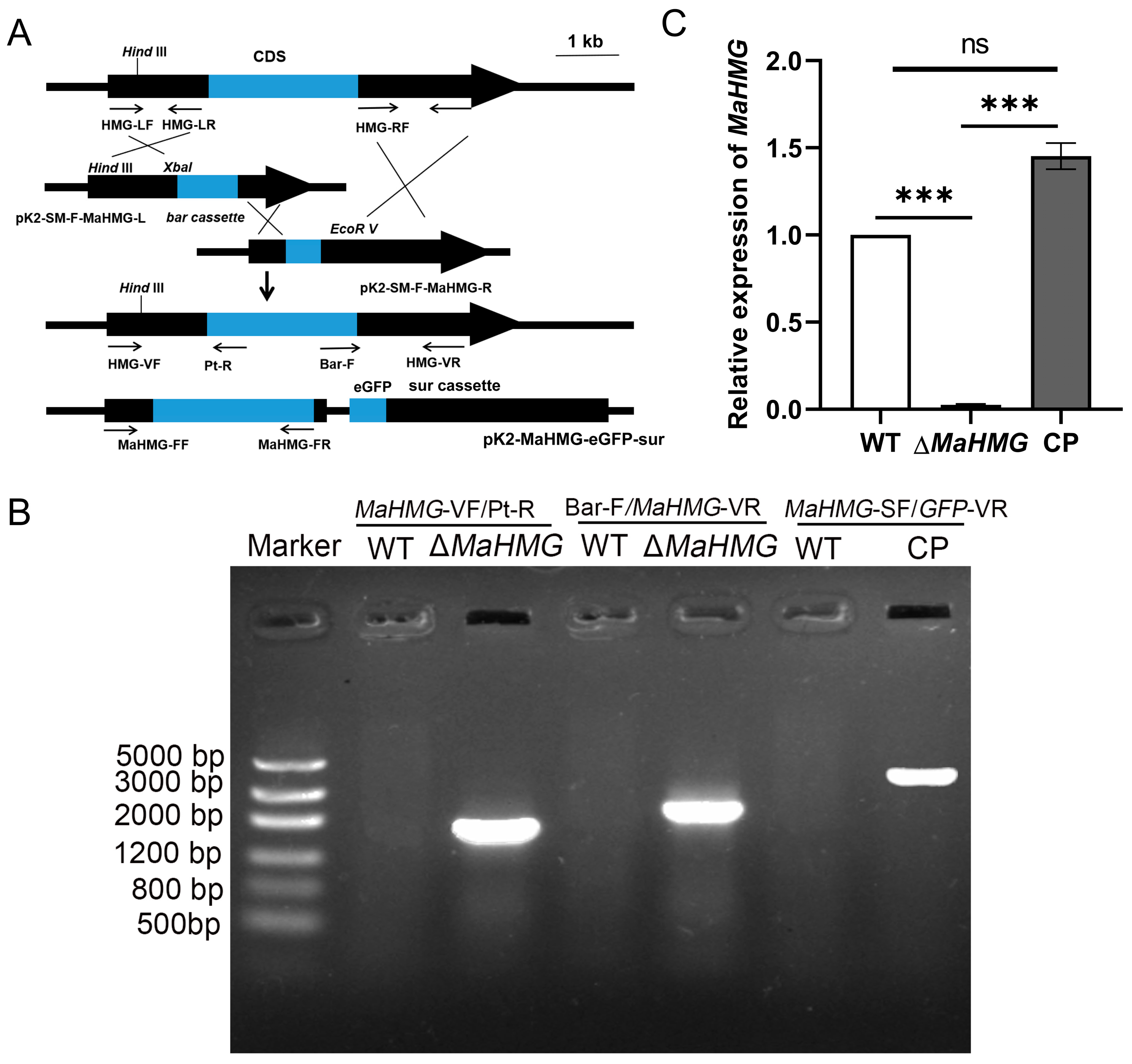
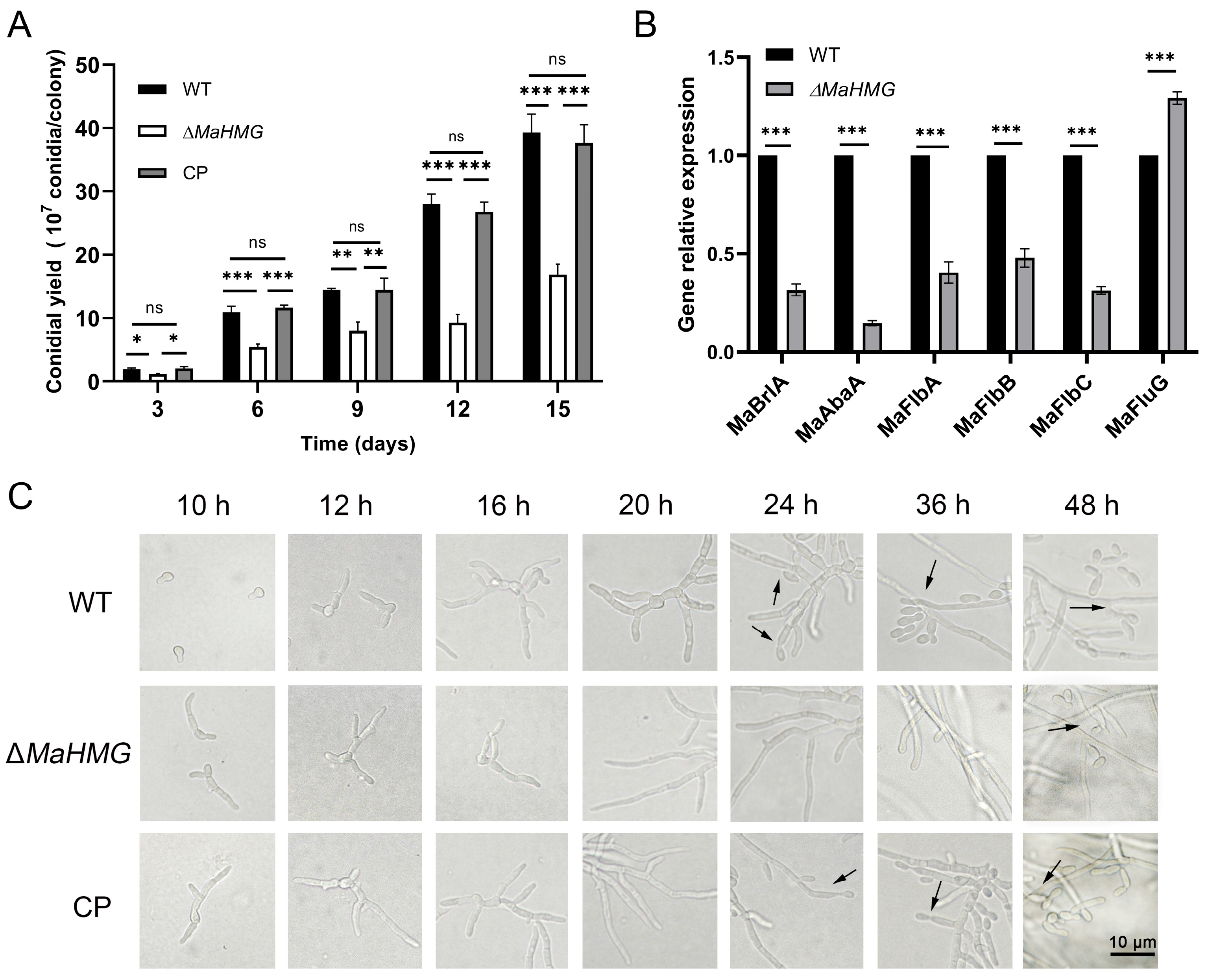
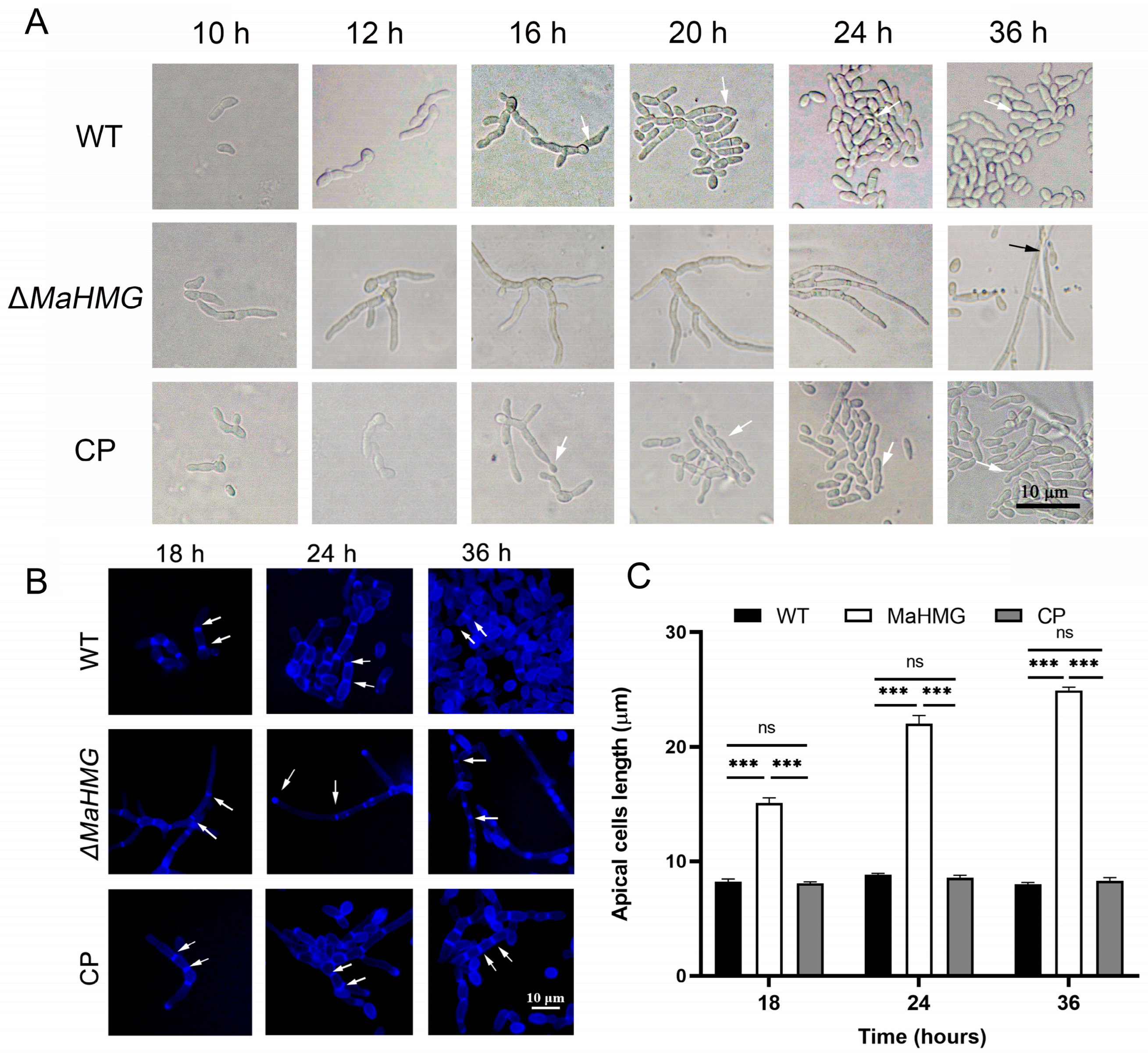
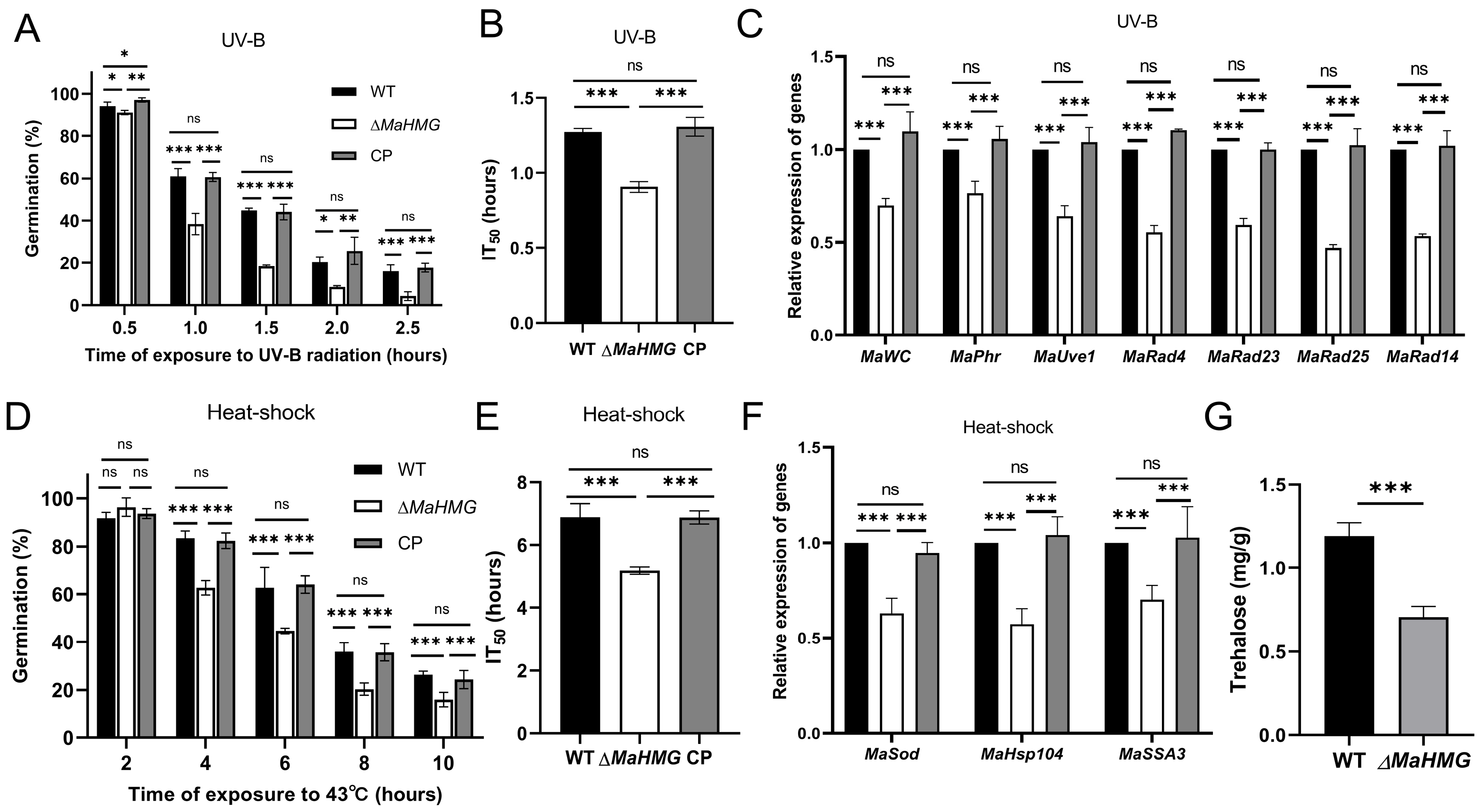
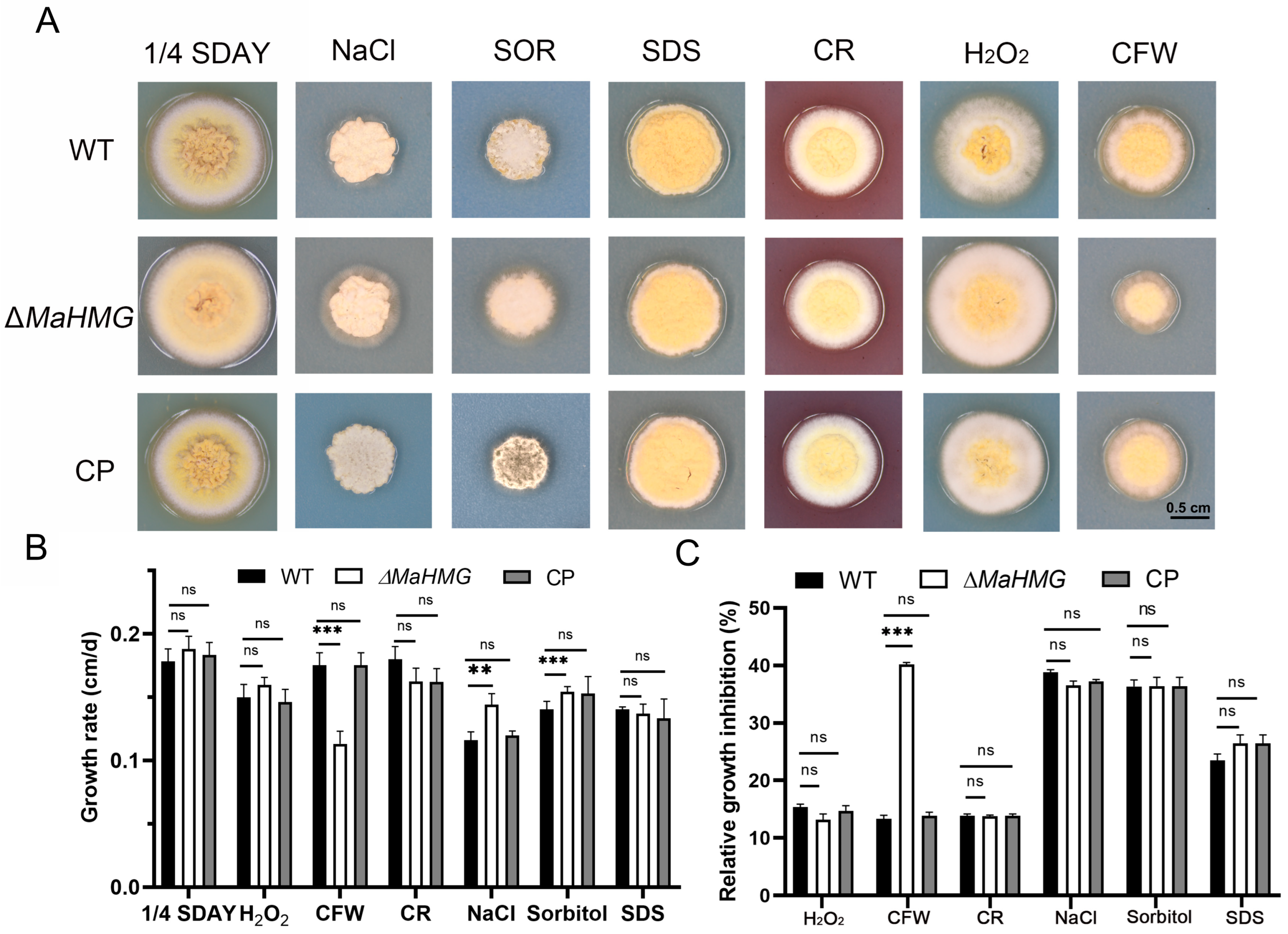
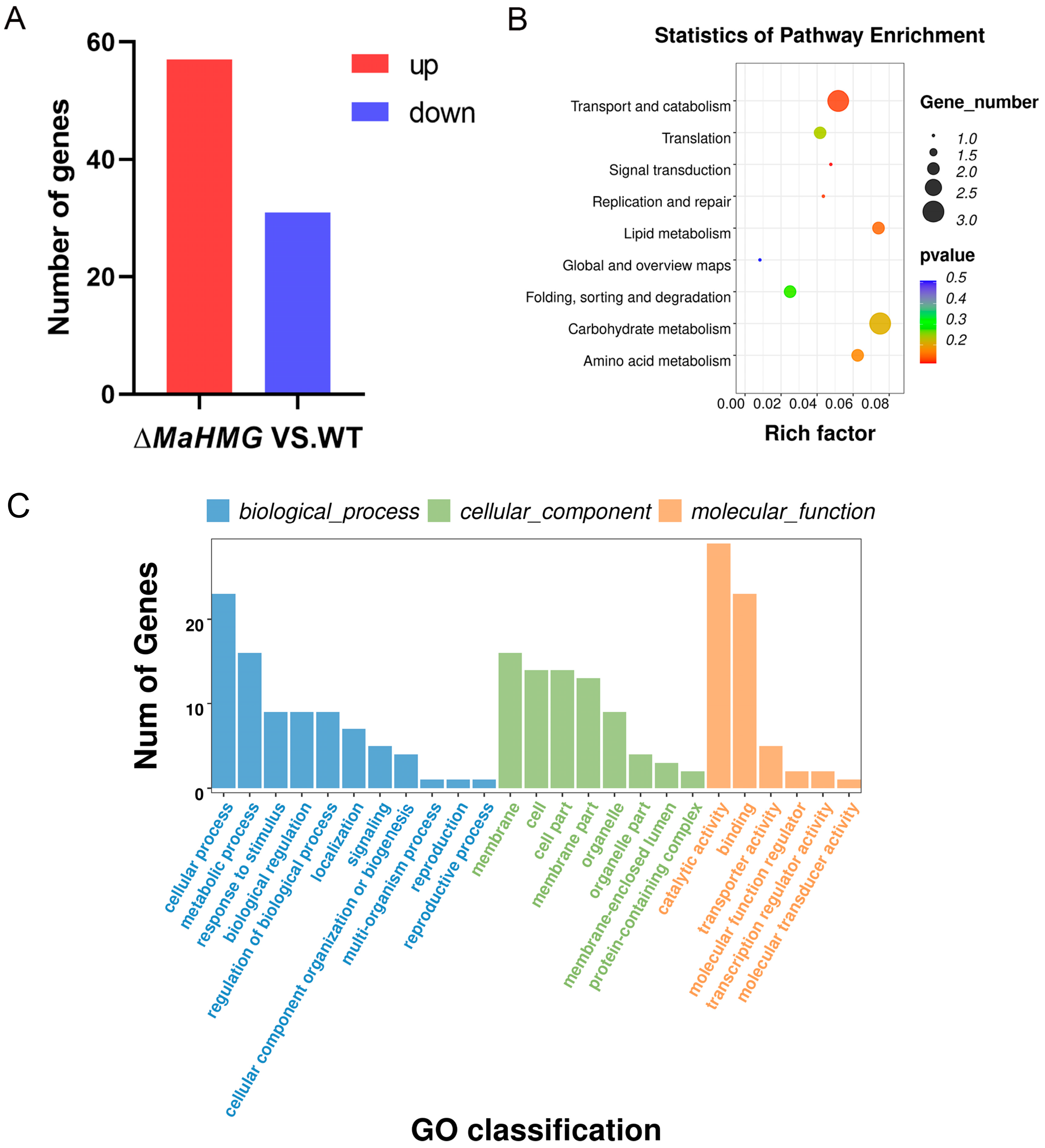
Disclaimer/Publisher’s Note: The statements, opinions and data contained in all publications are solely those of the individual author(s) and contributor(s) and not of MDPI and/or the editor(s). MDPI and/or the editor(s) disclaim responsibility for any injury to people or property resulting from any ideas, methods, instructions or products referred to in the content. |
© 2025 by the authors. Licensee MDPI, Basel, Switzerland. This article is an open access article distributed under the terms and conditions of the Creative Commons Attribution (CC BY) license (https://creativecommons.org/licenses/by/4.0/).
Share and Cite
Qiu, R.; Zhou, J.; Cao, T.; Xia, Y.; Peng, G. Transcription Factor MaHMG, the High-Mobility Group Protein, Is Implicated in Conidiation Pattern Shift and Stress Tolerance in Metarhizium acridum. J. Fungi 2025, 11, 628. https://doi.org/10.3390/jof11090628
Qiu R, Zhou J, Cao T, Xia Y, Peng G. Transcription Factor MaHMG, the High-Mobility Group Protein, Is Implicated in Conidiation Pattern Shift and Stress Tolerance in Metarhizium acridum. Journal of Fungi. 2025; 11(9):628. https://doi.org/10.3390/jof11090628
Chicago/Turabian StyleQiu, Rongrong, Jinyuan Zhou, Tingting Cao, Yuxian Xia, and Guoxiong Peng. 2025. "Transcription Factor MaHMG, the High-Mobility Group Protein, Is Implicated in Conidiation Pattern Shift and Stress Tolerance in Metarhizium acridum" Journal of Fungi 11, no. 9: 628. https://doi.org/10.3390/jof11090628
APA StyleQiu, R., Zhou, J., Cao, T., Xia, Y., & Peng, G. (2025). Transcription Factor MaHMG, the High-Mobility Group Protein, Is Implicated in Conidiation Pattern Shift and Stress Tolerance in Metarhizium acridum. Journal of Fungi, 11(9), 628. https://doi.org/10.3390/jof11090628






